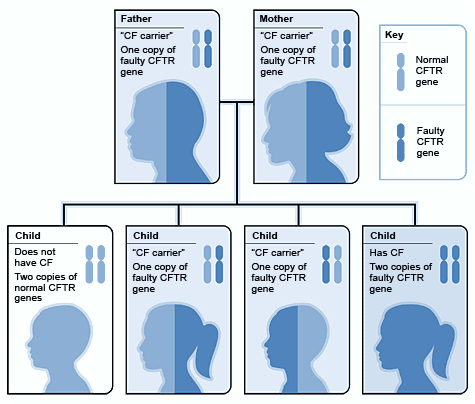Cystic fibrosis is a genetic condition that affects the production and flow of mucus within the lungs and digestive system. As a result, the passage ways in these areas become clogged with a thick, sticky mucus.
The condition is caused by an abnormality in a protein channel that regulates the movement of sodium and chloride in and out of cells. This protein is called the cystic fibrosis transmembrane conductance regulator (CFTR). In cystic fibrosis, mutation of the CFTR gene leads to the formation of a protein that lets too much salt and not enough water into the cells. This leads to a build up thick and sticky mucus in the tubes and passageways of the lungs and respiratory system, which become damaged, infected and inflamed.
Pattern of inheritance of the CFTR mutation
All genes are present in pairs in the body, with one copy present on each chromosome. Humans have 23 pairs of chromosome, with 23 chromosomes inherited from the mother and 23 from the father.
For cystic fibrosis to develop, the child has to inherit a defective copy of the CFTR gene from both parents. Inheriting one gene with the mutation makes a person a carrier, who may produce affected offspring if their partner is also a carrier.
In the United Kingdom, 1 person in every 25 carries the faulty gene for cystic fibrosis and in the United States of America, nearly 12 million people are carriers. Carriers are healthy and have no symptoms of the disease condition.
If two carriers of the faulty gene produce a baby together, there is a one-in-four chance that the child will not inherit either of the faulty genes, but also a one in four chance they will inherit both of the mutated genes and develop cystic fibrosis. There is a one-in-two chance that the child will inherit one faulty gene and will be a carrier.
Inheritance Pattern for Cystic Fibrosis

Source: National Heart, Lung, and Blood Institute
Further Reading